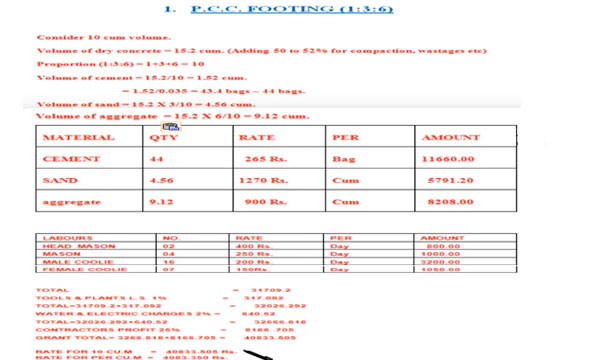How to perform rate analysis for P.C.C. Footing
- Concrete Cost Estimator
- Concrete Continuous Footing
- Landscape Bidding and Estimating
- Construction Cost Estimating
- Concrete and steel cost estimation
- Construction Cost Estimate Breakdown
- Construction Estimating Worksheet
- Home Construction Cost Estimate
- Estimate Pricing Sheet
- Sheet for General Contractor
- Construction Cost Estimate
- Labor Materials Cost Estimator
- Masonry Estimating Sheet
- Sheet for Building Contractor
- Construction Schedule Bar chart
- General Cost Estimator Sheet
- General Construction Estimate
- Building and Road Estimating Sheet
- Detailed expense estimates
- Door and Window Takeoff Sheet
- General Construction Cost Estimating Sheet

This construction video is based on Rate Analysis that is very important factor in Civil or building works. The objective of rate analysis is to find out the unit quantity price of each construction material.
After that, multiply this unit quantity with total quantity of materials in BOQ to obtain the total volume as well as total cost of the building.
The rate analysis is dependent on the following factors :-
1. Specifications of works and material regarding their quality, proportion and constructional operation method.
2. Quantity of materials and their costs.
3. Cost of labors and their wages.
4. Placement of site of work and the distances from source and conveyance charges.
5. Overhead and establishment charges
6. Profit
Objective of rate analysis :-
1. To calculate the real cost of per unit of the items.
2. To compute the reasonable use of materials and processes in finalizing the specific items.
3. To calculate the cost of extra items which are not included in the contract bond, but should be performed following the directions of the department.
4. To modify the schedule of rates because of the rise in the cost of material and labor or modification in technique.
Here, in this video, rate analysis is prepared for PCC footing. The mix ratio is taken as (1:3:6) i.e. cement = 1, sand = 3 and aggregate = 6.
Volume of dry concrete = 15.2 cum (after deleting all the voids we get 10 cum)
Volume of cement = 15.2/10 = 1.52 cum (adding all the ratios, we get 10)
Now, 1 bag of cement contains 0.035 cum
So, total number of bags required = 1.52/0.035 = 43.4 = 44 bags.
Therefore, volume of sand = 15.2 x 3/10 = 4.56 cum
Volume of aggregate = 15.2 x 6/10 = 9.12 cum
To get the complete details, watch the following video.
Video Source: Parag Pal

- Application of concrete calculator
- Roofing Calculator can streamline the roof estimating process
- House construction cost calculator
- Engineering column design excel spreadsheet
- Material Estimating Sheet with Excel
- Materials List and Cost Estimate Worksheet
- Concrete Slab Estimating Calculator Sheet
- Common types of foundations for buildings
- Online calculation of construction materials
- Estimating with Excel for the Small Contractor
- Concrete Beam Design Spreadsheet
- Virtual Construction Management app for construction
- Autodesk’s Project Skyscraper
- Reed Construction’s Reed Insight
- Manage your construction project documentation
- Costimator, the popular cost estimating software
- On Center Software for construction professionals
- Free Construction Estimating Software
- Plumbing Calc Pro
- Cost Estimate Worksheet
- HVAC Piping Quantity Takeoff Worksheet
- Construction Estimating Software Sheet
- Estimate Cost Templates
- Construction Punch List
- Construction cost estimating template consisting estimating basic
- Gantt Chart Template for Excel
- Download Civil Engineering Spreadsheets with Verification
- The Building Advisor Estimating and Budgeting Worksheet
- Spreadsheet for design of concrete bridge
- Construction Estimating Software Free








